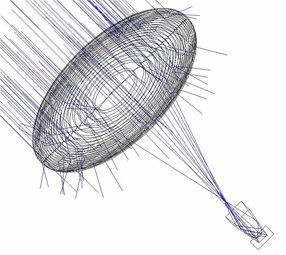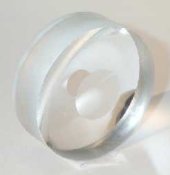
Solar concentrators in general must meet the following requirements:
Another fundamental requirement in the design of the collector is the size and uniformity of the image which must be sized in such a way as to be able to match the characteristics of the chosen photovoltaic cell.
One of the most popular types of lenses is the Fresnel lens, which is widely used as a solar light collector.
 The main advantage of this optical component is its very thin thickness. The Fresnel lens is designed to have only the curvature of the optical surface without being filled with the material constituting the lens. In practice, a Fresnel lens can be obtained from an ordinary lens by sectioning the lens into circular rings, from the center on the optical axis, and holding only the edge (2 - 3 mm thick) of each concentric section. The result is a lens that resembles an old vinyl LP record and is characterized by concentric ring symmetry, with different curvatures and distances from the center of the lens. Typically Fresnel lenses are made of plastic, with a thickness of a few millimeters. As solar concentrators, Fresnel lenses can achieve quite high levels of collection efficiency. They can be coupled to PV cells, but they need a secondary to homogenize the beam incident on the cell and reduce losses, as the PV cell is square in shape while the image created by the lens is round.
The main advantage of this optical component is its very thin thickness. The Fresnel lens is designed to have only the curvature of the optical surface without being filled with the material constituting the lens. In practice, a Fresnel lens can be obtained from an ordinary lens by sectioning the lens into circular rings, from the center on the optical axis, and holding only the edge (2 - 3 mm thick) of each concentric section. The result is a lens that resembles an old vinyl LP record and is characterized by concentric ring symmetry, with different curvatures and distances from the center of the lens. Typically Fresnel lenses are made of plastic, with a thickness of a few millimeters. As solar concentrators, Fresnel lenses can achieve quite high levels of collection efficiency. They can be coupled to PV cells, but they need a secondary to homogenize the beam incident on the cell and reduce losses, as the PV cell is square in shape while the image created by the lens is round.
 Some concentrators have an original configuration called Monobloc Catadioptric Concentrator ( CCM ), which is it has been designed in order to optimize both the optical characteristics (collection efficiency, aberrations, etc.) and the compactness of the component to be made (dimensions and weight).
Some concentrators have an original configuration called Monobloc Catadioptric Concentrator ( CCM ), which is it has been designed in order to optimize both the optical characteristics (collection efficiency, aberrations, etc.) and the compactness of the component to be made (dimensions and weight).
The optical principle of this collector consists of two optical elements in a coaxial configuration, similar to the Cassegrain one. The CCM is made in a single piece, this allows to obtain an object characterized by reduced dimensions and great mechanical stability. To increase efficiency, the CCM has aspherical surfaces, the realization of which requires the development of particular procedures
production, this makes the realization of the component complex and expensive. These lenses also produce a round sun image for which the insertion of a secondary must be evaluated.
Another interesting plastic collector applied to the concentration of sunlight is the Prismatic Lens ( PV collectors),  which has the great advantage of creating a square image. This optical element also has a very reduced thickness, of the order of a few millimeters (5 - 6 mm). The construction principle of the prismatic lens is similar to the concept of Fresnel's realization, but for the prismatic lens the symmetry is orthogonal instead of radial as for the Fresnel lenses. The surface of the prismatic lens is homogeneously divided with a lattice that covers the area of the lens. The basic element, called "tile" as in a mosaic, is a prism with faces oriented in order to direct the light to form the desired image. The dimensions and orientation of the prism of each "tile" are calculated through an appropriate optical project to concentrate the light on the image. In the field of solar concentration, the correct design must be conducted so that the image created by the prismatic lens corresponds to the area of the PV cell, which typically has a square shape, while at the same time creating a spot as homogeneous as possible.
which has the great advantage of creating a square image. This optical element also has a very reduced thickness, of the order of a few millimeters (5 - 6 mm). The construction principle of the prismatic lens is similar to the concept of Fresnel's realization, but for the prismatic lens the symmetry is orthogonal instead of radial as for the Fresnel lenses. The surface of the prismatic lens is homogeneously divided with a lattice that covers the area of the lens. The basic element, called "tile" as in a mosaic, is a prism with faces oriented in order to direct the light to form the desired image. The dimensions and orientation of the prism of each "tile" are calculated through an appropriate optical project to concentrate the light on the image. In the field of solar concentration, the correct design must be conducted so that the image created by the prismatic lens corresponds to the area of the PV cell, which typically has a square shape, while at the same time creating a spot as homogeneous as possible.
CNR-INO Istituto Nazionale di Ottica - Largo Fermi 6, 50125 Firenze - Tel. +39 05523081 - P.iva 02118311006 - Info: info@ino.cnr.it